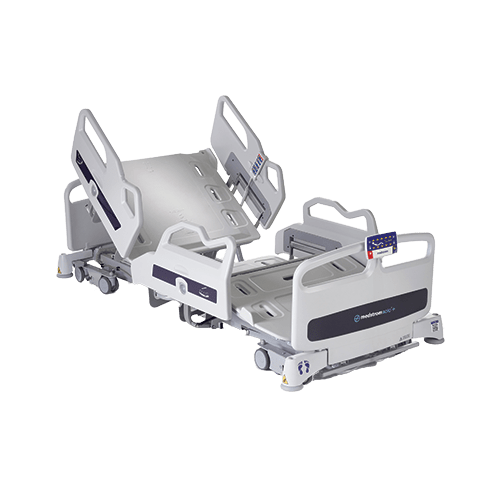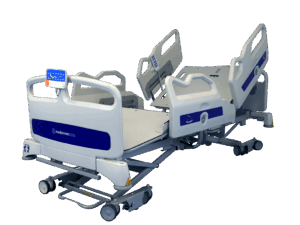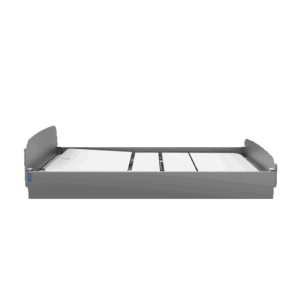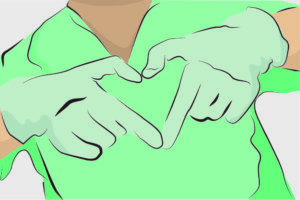
Best Hospital Beds for Elderly Patients
The UK has an ageing population and in-patient falls are the most frequently reported safety incident with more than 250,000 recorded each year in England and Wales.1 It is therefore important to provide an adequate hospital bed for elderly patients that works to avoid falls and ensures comfort at the same time.
Elderly patients, who may have multiple co-morbidities and very frail may also be:
- Drowsy due to medication
- Confused or suffering from delirium
- Dementia sufferers
They are therefore at a very high risk of falls.
Falls Prevention
Beds with an ultra-low minimum height are recognised to be safer for patients that are at risk from falls and associated injuries, and to help with safer mobilisation from the bed.
The best hospital beds for elderly patients should have a bed height range that can accommodate all patients who are at risk of falls. Beds that cannot achieve a low enough height serve only to contribute towards the epidemic number of falls and negatively impacting mobilisation.
The availability of one low or ultra-low bed for three standard beds may contribute to a decrease in the rate of serious fall-related injuries,2 whereas providing one low or ultra-low bed per 12 beds doesn’t seem to affect rate of falls.3
The Medstrom SOLO bed can address these falls management challenges because it has an ultra-low height of 21cm from the floor to the top of the sleep deck. This low height significantly reduces the impact force of a fall compared to higher beds – click here for the data which demonstrates this.
What is the best height for patients to mobilise from a hospital bed?
From an elderly patient’s perspective, if both feet are not flat on the floor this can create uncertainty about the safety of mobilising, which in turn will affect their independence. Data shows that 22% of patients who fall in hospitals do so from the bed.4
The popliteal height (feet flat on the floor) is the safest for mobilisation. In addition to the ultra-low height, the Medstrom SOLO bed has a unique, programmable custom height function which provides bespoke patient care whilst delivering maximum protection. It allows therapists and nursing staff to work with each elderly patient in identifying their popliteal height and set the correct custom height for egress. This allows patients to mobilise safely from the bed, with their feet firmly on the floor, which promotes confidence and encourages early mobilisation.
Published popliteal height data5,6 has been analysed to determine the proportion of the population that would be able to achieve a safe position (feet flat on the floor) with beds of varying low heights. The table summarises the findings:
Percentage of Patients able to Egress a Bed Safely at Various Minimum Bed Heights
| Bed Low Height* | Safe Egress (Males) | Safe Egress (Females) |
| 21cm | > 99% | > 96% |
| 32cm | 16% | < 1% |
| 38cm | < 1% | < 1% |
*Bed platform height (14cm mattress on top)
Therefore, the Medstrom SOLO bed which has an ultra-low bed height of 21cm will provide the greatest protection for elderly patients when attempting to safely mobilise, whatever their height. It also significantly helps with falls prevention and minimising the risk of injury from a potential fall.7
Side Rails
Split side rails can also be used as a mobilisation aid for the elderly patient, offering a sturdy grip for the patient to hold on to when standing. With the Medstrom SOLO bed, a clinical choice between split or folding side rails can be made, with the added advantage that both options have the same ultra-low height of 21cm.
The Medstrom SOLO side rails are BS EN ISO 60601-2-52 compliant, to minimise entrapment risks and provide maximum patient safety.
In summary, the best hospital beds for elderly patients should:
- Have a low enough platform height to minimise injuries from falls
- Have a height range which allows safe egress from the bed for all heights of patient
- Have added benefits such as split side rails which are compliant to the latest safety standards and can double up as mobilisation aids, with no compromise on low height
This will allow the safe mobilisation of patients, promote positive outcomes, help with falls prevention and reduce the risk of injuries that are associated with falls.
View Our Range of Hospital Beds












